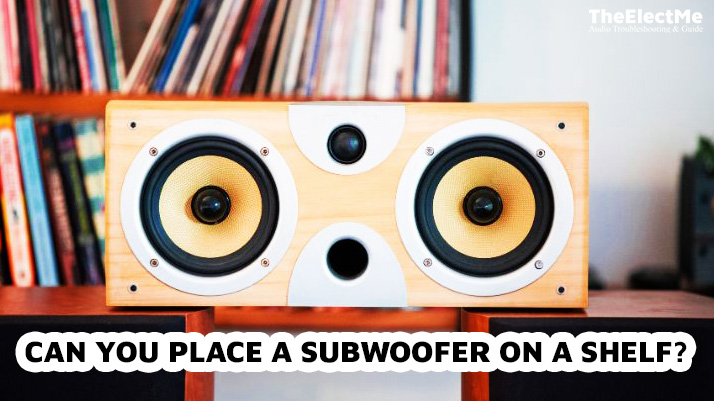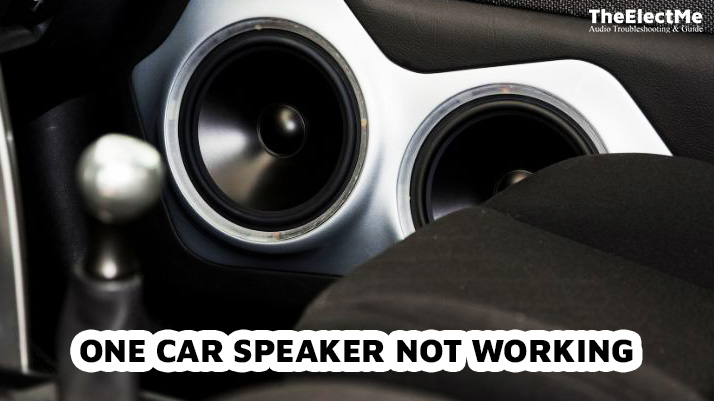Can you place a subwoofer on a shelf? Yes, you can place your subwoofer on a shelf. But before you do so, it’s essential to understand the dos and don’ts of this placement. Subwoofer placement can significantly impact the sound quality of your audio system, so it’s critical to get it right.

A wrong placement can result in muffled or distorted bass, ruining your listening experience. When positioning a subwoofer on a shelf, several factors should be considered.
Begin with what you should consider when placing a subwoofer on a shelf.
What To Consider When You Place A Subwoofer On A Shelf?
For optimal sound quality, the placement of your subwoofer is crucial. When placing it on a shelf, you should consider the following factors:
1. Stability of the Shelf
The stability of the shelf is essential when placing a subwoofer on it. Subwoofers tend to vibrate and produce low-frequency sounds, which can cause the shelf to shake or wobble if it’s not stable enough. This can lead to sound distortion and affect the overall performance of your audio system.
To ensure that your shelf is stable enough for a subwoofer, you can check its weight capacity and the material it’s made of.
Ideally, the shelf should support at least twice the weight of your subwoofer to ensure stability.
Additionally, consider using rubber padding or anti-vibration feet between the subwoofer and the shelf to reduce vibrations. You can also reinforce the shelf by using L-brackets or brackets with screws for added stability.
2. Size and Weight of the Subwoofer
The size and weight of your subwoofer play a crucial role in shelf placement. Subwoofers come in various sizes and weights depending on their power and features. There are two types of subwoofer. Dual drive subwoofer and single drive subwoofer. Placing a heavy or oversized subwoofer on a shelf not designed to support it can lead to potential safety hazards.
When considering the size and weight of your subwoofer, check the specifications provided by the manufacturer. Measure your subwoofer’s dimensions and weight, then compare them with your shelf’s maximum weight capacity.
Even if your shelf can support the weight of a subwoofer, there may be better placement locations. Place your subwoofer on a lower shelf or the floor for better stability and sound quality.
3. Airflow and Ventilation
Airflow and ventilation refer to the circulation of air around your subwoofer. Proper airflow is crucial for optimal performance and preventing overheating or damage to your subwoofer. Placing a subwoofer on a shelf with limited space and no ventilation can lead to poor sound quality and potential malfunctions.
Leave enough space between the subwoofer and the shelf walls to ensure proper airflow. Place the subwoofer on an open shelf or one with gaps for air to circulate freely. Avoid placing it in a closed cabinet or tight space.
4. Location of Other Audio Equipment
The location of other audio equipment, such as speakers or amplifiers, can impact the placement of your subwoofer on a shelf. Placing your subwoofer too close to other equipment can result in sound interference and distortion.
To avoid this, leave enough space between the subwoofer and other equipment. Additionally, consider the wiring and cable connections of your audio system.
Placing a subwoofer on a shelf above or below other equipment may make it challenging to connect cables and wires properly.
Ensure easy access for proper installation and maintenance. After considering these factors, let’s move on to the step-by-step guide on correctly placing a subwoofer on a shelf.

A Step By Step Guide To Place A Subwoofer On A Shelf
When placing a subwoofer on a shelf, follow these steps for optimal sound quality and safety:
Step No 1: Clean the Shelf
Before placing your subwoofer on a shelf, clean it thoroughly. Remove any dust or debris that may have accumulated to ensure proper contact between the subwoofer and the shelf. You can also use rubber padding or anti-vibration feet for added stability.
Step No 2: Measure and Check Specifications
Measure your subwoofer’s dimensions and weight, then check your shelf’s maximum weight capacity. For measurement, read the specifications provided by the manufacturer of both the subwoofer and shelf. Ensure that your shelf can support at least twice the weight of your subwoofer for optimal stability.
Step No 3: Choose a Desire Shelf
Choose a stable, strong shelf that accommodates your subwoofer’s weight and dimensions. An open shelf with enough space for air circulation is ideal. Avoid placing it on a glass or particleboard shelf, as they may not provide enough stability.
Step No 4: Place the Subwoofer
Place your subwoofer on the desired shelf, ensuring it’s stable and doesn’t wobble. Leave enough space between the subwoofer and the shelf walls for proper airflow. You can also use L-brackets or brackets with screws for added stability.
Step No 5: Connect Cables and Wires
Connect cables and wires to your subwoofer according to the manufacturer’s instructions. Ensure easy access for proper installation and maintenance.
Step No 6: Test and Adjust Placement
Once your subwoofer is placed on the shelf, test it by playing music or movies with a lot of bass. Listen for any sound distortion or interference. If needed, adjust the placement of your subwoofer for optimal good quality.
With these steps, you can enjoy optimal sound quality from your audio system with a properly placed subwoofer on a shelf. After you place the subwoofer, you check the sound and notice it may be rattling. Why does your subwoofer rattle and how to fix it? Click here to learn the ins and outs of subwoofer rattle click here.
After following these steps, let’s move to the benefits and drawbacks of placing a subwoofer on a shelf.

Pros And Cons Of Placing A Subwoofer On A Shelf
A subwoofer on a shelf may have its advantages and disadvantages. Let’s take a look at some of them:
Advantages of Shelf Placement
Here are some benefits of placing a subwoofer on a shelf:
- Elevation and Sound Distribution: Placing the subwoofer on a shelf can improve sound distribution. The elevated position can evenly distribute the low frequencies throughout the room.
- Space-Saving: Placing a subwoofer on a shelf can save space in your room, mainly if you have limited floor space for placement.
- Easy Access: An adequately placed subwoofer on a shelf makes it easier to access and maintain. You won’t have to deal with wires and cables cluttered on the floor.
Disadvantages of Shelf Placement
Here are some drawbacks of placing a subwoofer on a shelf:
- Limited Stability: A shelf may not provide enough stability for larger or heavier subwoofers, leading to potential safety hazards and sound interference.
- Restricted Airflow: Placing a subwoofer on a shelf with limited space can restrict airflow, resulting in poor sound quality and potential damage to the subwoofer.
- Complex Cable Management: Placing a subwoofer on a shelf may make it challenging to manage cables and wires, leading to messy and cluttered setups.
After considering these pros and cons, you can decide if placing your subwoofer on a shelf is the right choice for your audio setup. Remember to prioritize safety and optimal sound quality when deciding on placement.
Final Thoughts – Subwoofer On A Shelf
To sum up, your subwoofer’s placement can significantly impact your room’s overall sound quality. However, it’s essential to balance this with safety considerations and aesthetics.
A well-placed subwoofer should enhance your listening experience without harming the equipment or furniture. It should also blend seamlessly with your room’s decor. Remember, while shelf placement has advantages, it’s crucial to ensure the shelf is sturdy enough to handle the weight and vibrations of the subwoofer.



